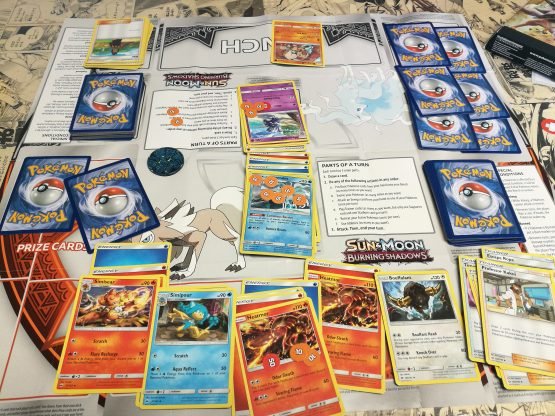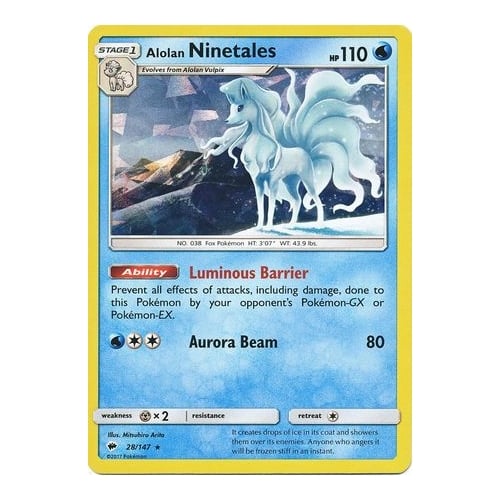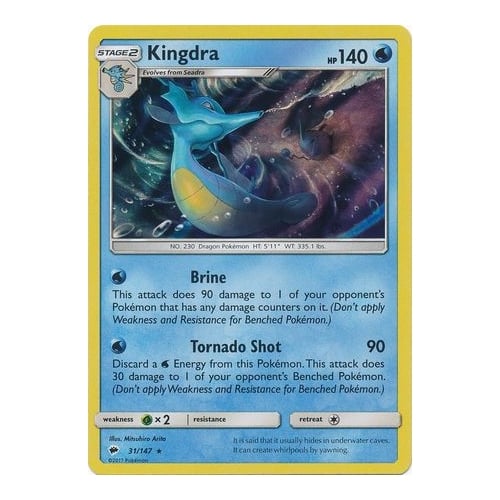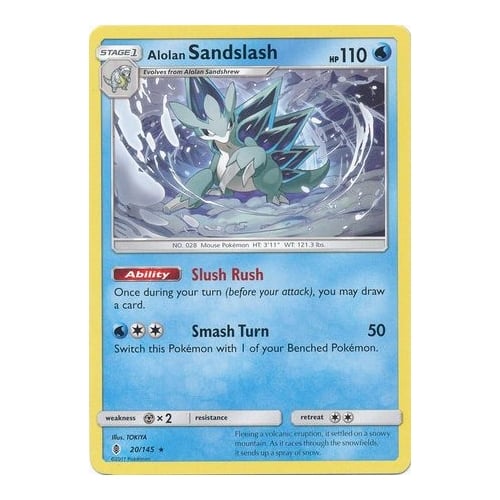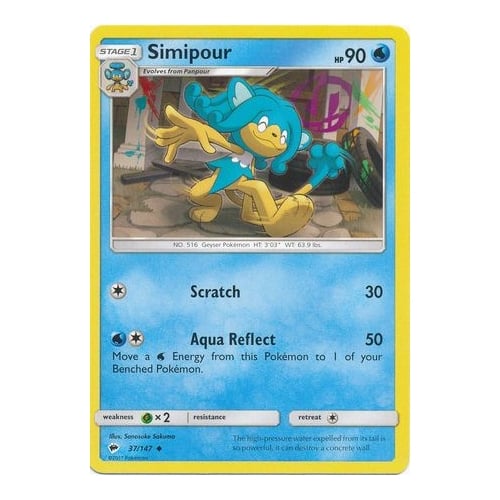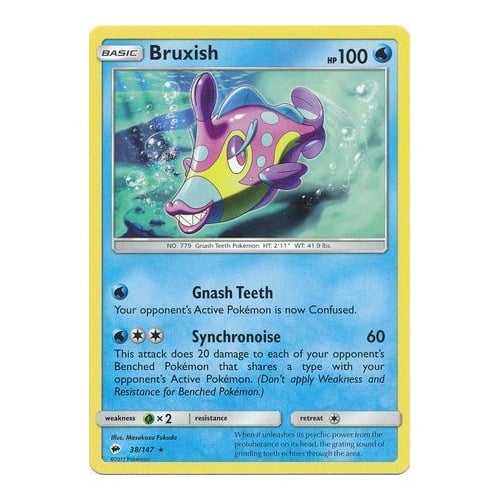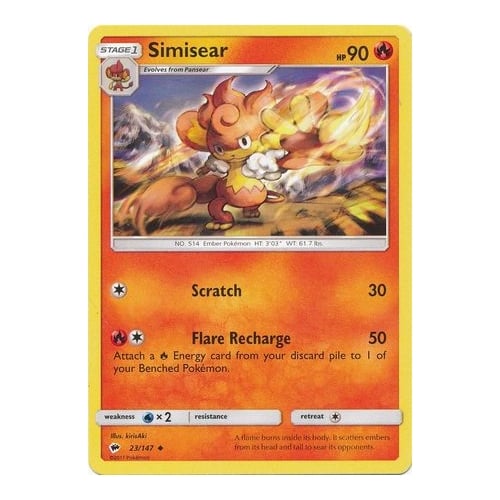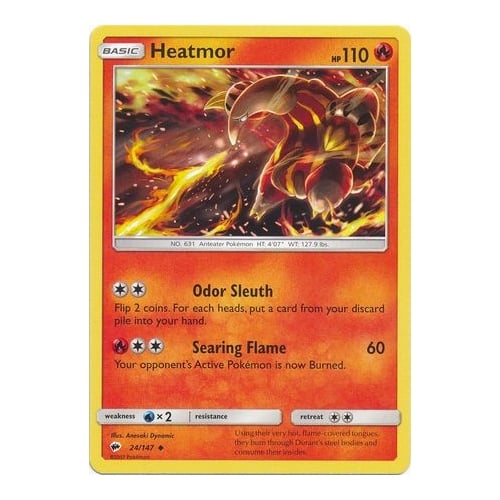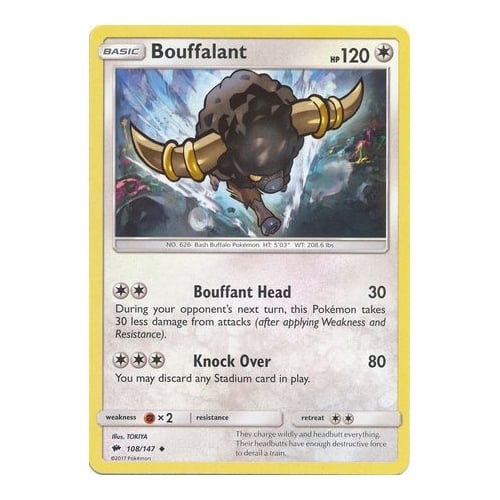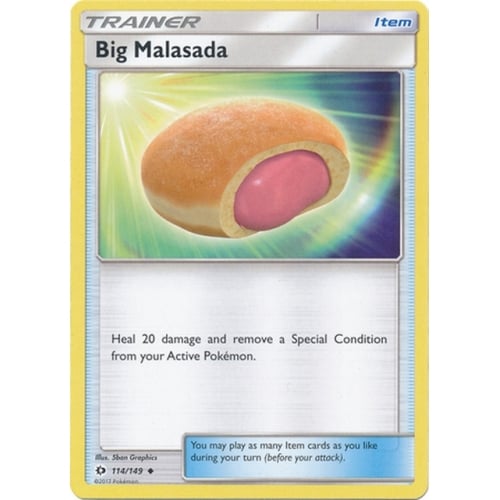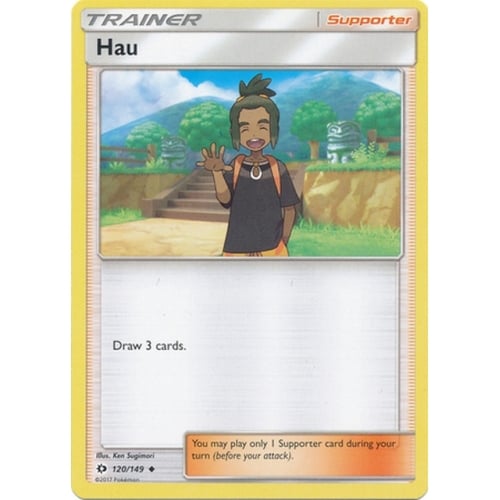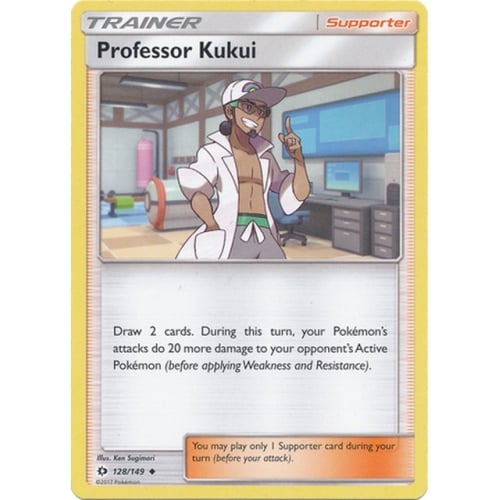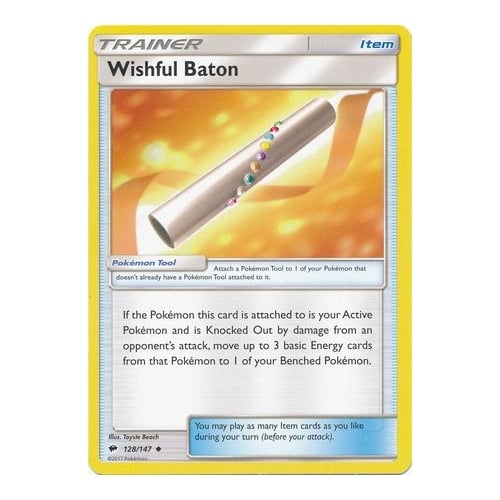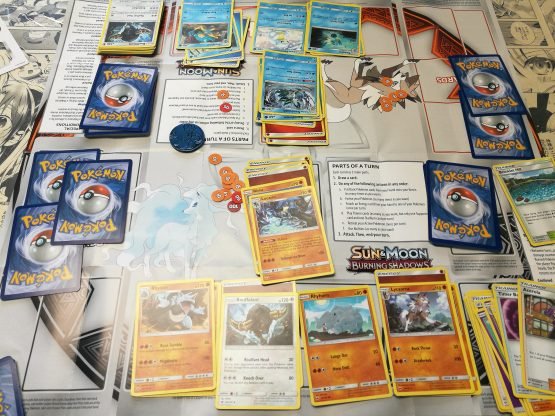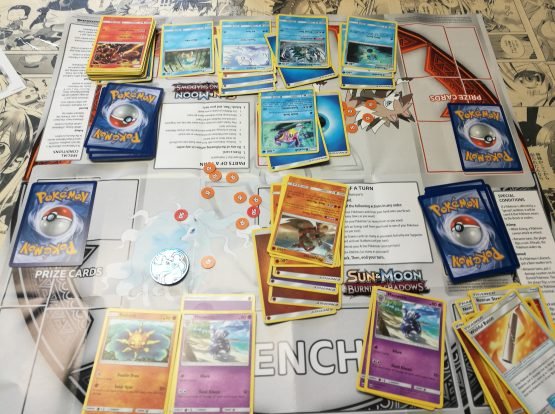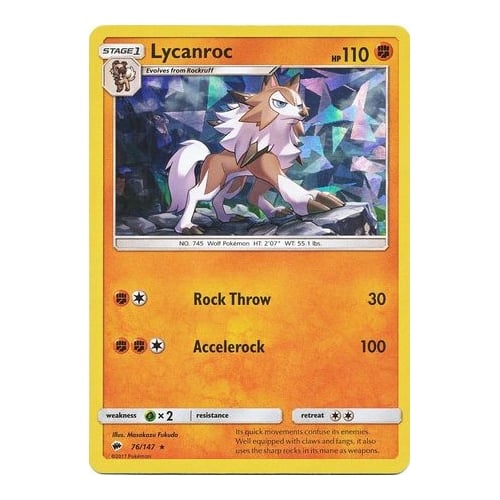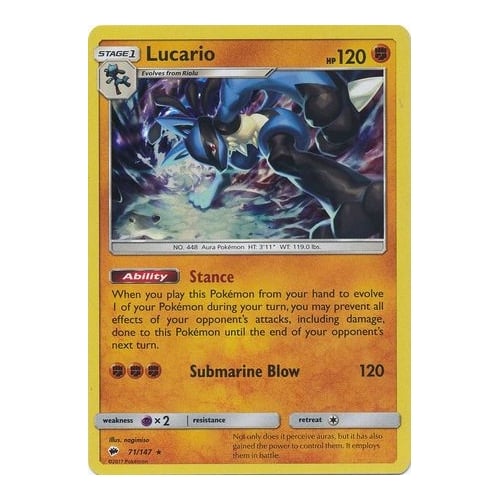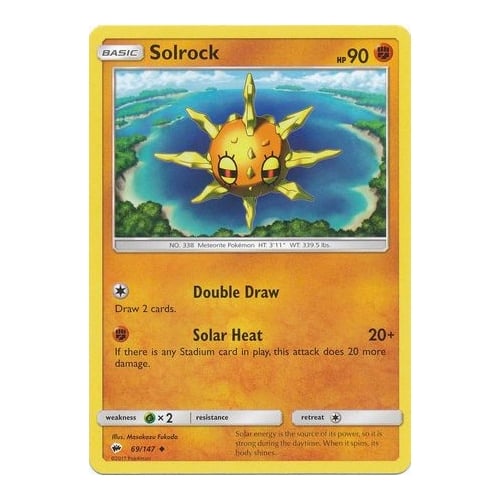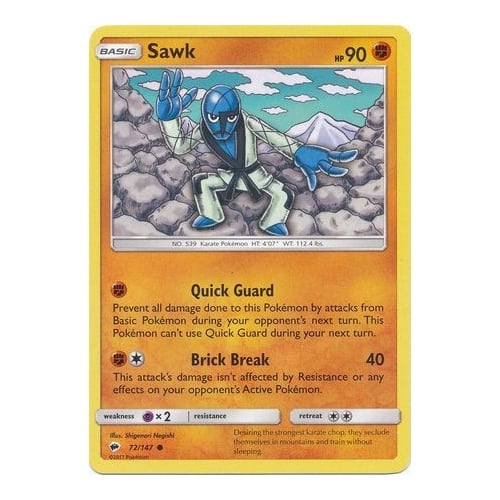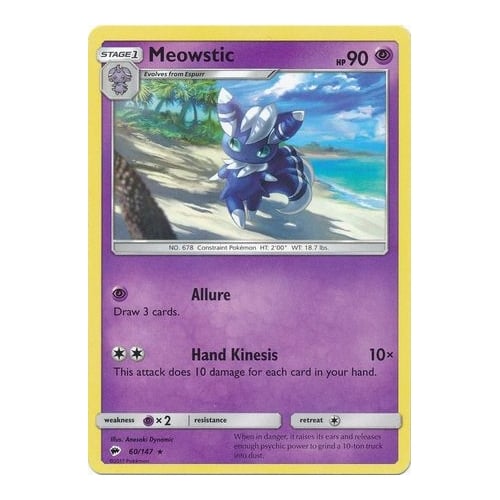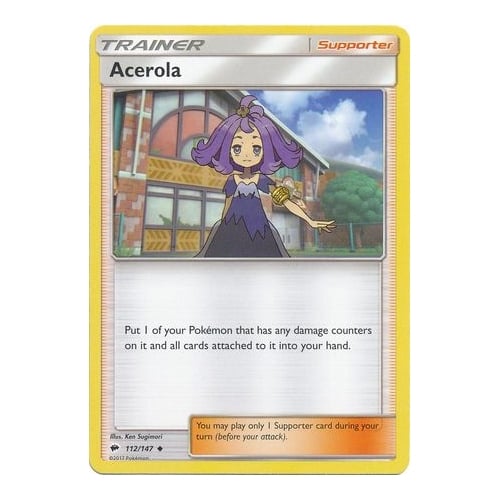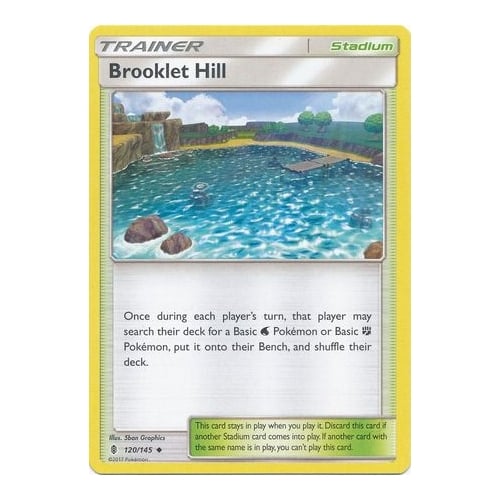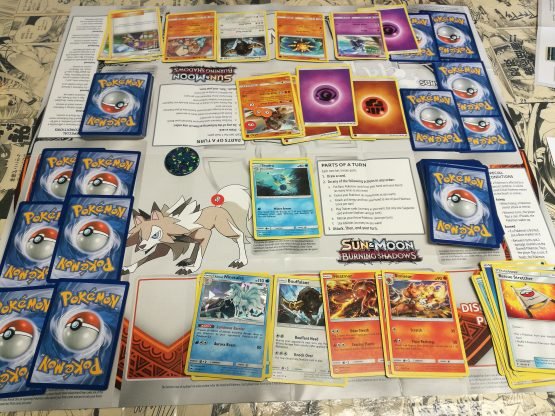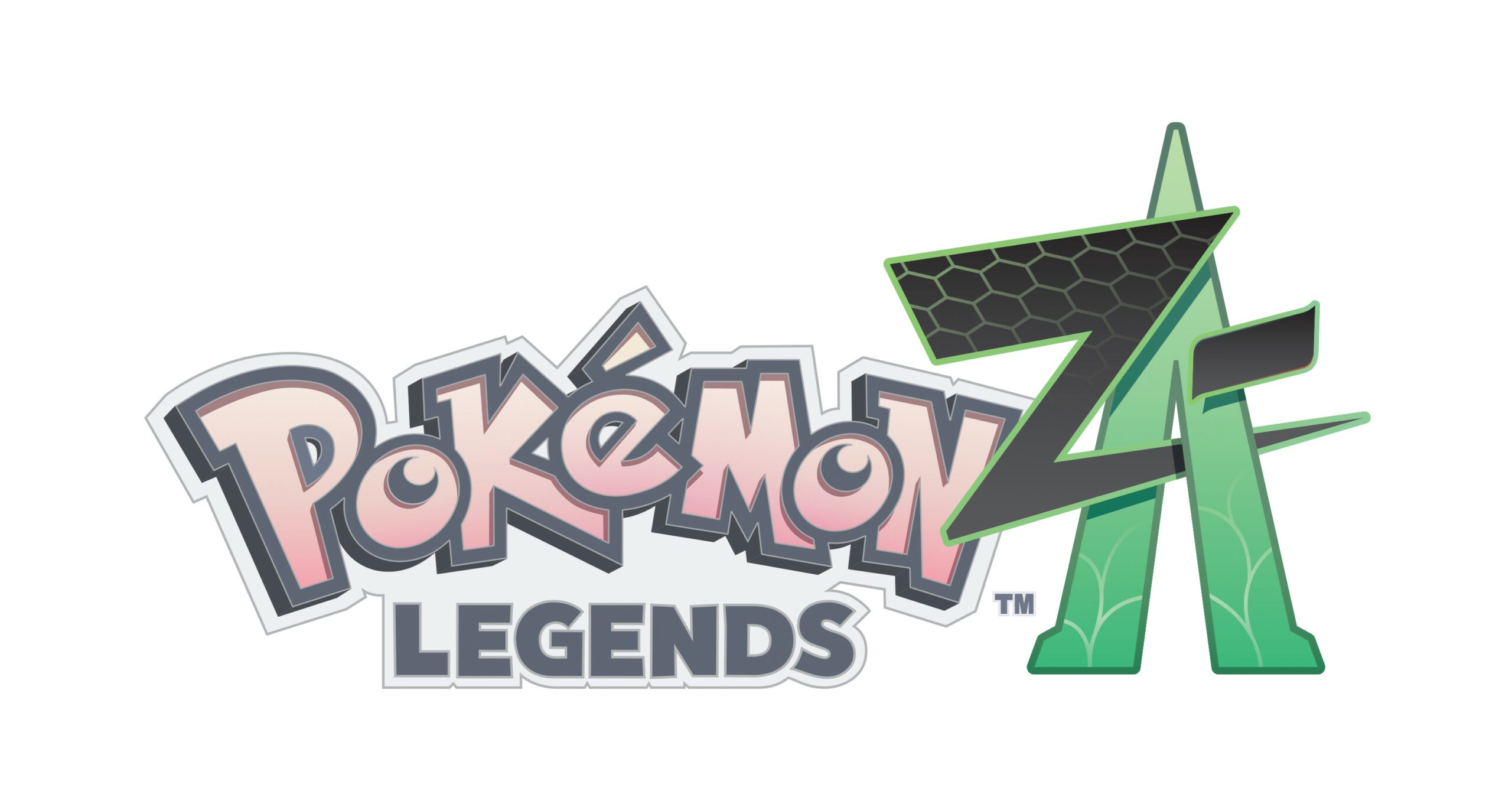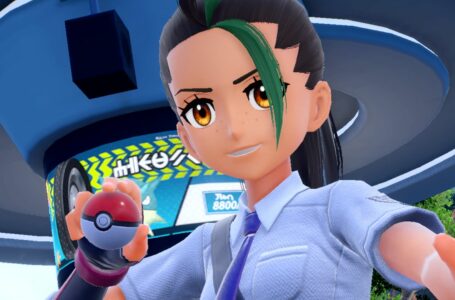Pokémon TCG: Sun & Moon Burning Shadows First Impressions — Rock Steady & Luminous Frost Theme Deck Reviews
As we already mentioned, the Pokémon Trading Card Game’s latest expansion, Sun & Moon Burning Shadows, just released — and it’s filled with some pretty interesting cards. We got hands-on with both of the expansions theme decks to get started with the set, and give us a first look at these new cards in action.
We’ll be taking a quick look at what sticks out with both decks individually, then looking at our thoughts on both of them together and how it is as an introduction to the Burning Shadows expansions. We only played the decks against one another to keep it level and fair.
Luminous Frost Review (Water & Fire)
Despite being fire and water, it never really felt like we were hurting for specific energy. That’s because it is predominately a water deck, with some fire added in just for the spice. Barely anything in this deck requires too much energy, or specific energy to get their best moves out. Only one or two Pokémon in this deck needs more than a single energy of its type for any of their moves. You could easily adjust the Pokémon in here because of this.
Let’s break these cards down, though, and take a long look at them. We’ll be going over some of the trainer cards later on as a unit, as most are shared between these two theme decks, but I really have it in for Big Malasada, which felt like a bit of a deadweight in this deck. Full deck list here.
1× Alolan Ninetales – Water (Rare Holo)
1× Alolan Ninetales – Water (Rare)
3× Alolan Vulpix – Water (Common)
To be honest, the star of the show, Alolan Nintetales, isn’t crazy special. It has a single attack, Aurora Beam (W/C/C — 80), that does 80 damage straight-up. No fuss, no muss. Sometimes it’s great to have a simple card like this to just get the job done. It’s backed up well by Kingdra and Alolan Sandslash, though. Together they form a solid trio of big hitters you can focus on trying to get out. Alolan Ninetales’ main advantage is complete immunity against GX and EX Pokémon, but it’s hard to plan for that advance, and obviously didn’t help in our test matches using these decks. It’d be interesting to see if it serves as a decent counter at higher level play.
1× Kingdra – Water (Rare)
2× Seadra – Water (Uncommon)
2× Horsea – Water (Common)
Kingdra is beastly, able to deal 90 damage to any Pokémon with damage counters using a single energy, and another single energy attack that discards that energy to do 90 damage, and a further 30 to a benched Pokémon. With just one in the deck, and being a third evolution, it’s hard to get out, but worth it when you do.
Both Horsea and Seadra only have one energy moves too, so you’ll never need to attach more, though comparatively they only do a paltry 10 damage and 30 damage respectively. You’ll really need to evolve it to get the most of this line, but you can dig in when you do, especially with a whopping 140HP.
2× Alolan Sandslash – Water (Rare)
2× Alolan Sandshrew – Water (Common)
The Alolan Sandlash is the most devious Pokémon in the deck, with an ability that lets you draw an extra card on your turn, and Smash Turn (W/C/C — 50) that switches Sandslash out for one of your benched Pokémon. You can really squeeze the most out of Sandslash using this, and put some pressure back on your opponent when you yourself are under pressure.
Alolan Sandshrew isn’t nearly as good in comparison, with Ice Ball (W/C/C — 30), which is pretty expensive for what it is. It does have a free Defense Curl which you can use to stall, but you won’t want to be sending this out at the start of the game if you can avoid it.
2× Simipour – Water (Uncommon)
2× Panpour – Water (Common)
Compared to its fiery cousin. Pansear/Simisear, this one comes out a little weak. They have similar attacks, both having Scratch (C — 30) that does chunky, clean damage, and then a more powerful two energy move that does 50. Unfortunately for Simipour, Aqua Reflect (W/C — 50) is a bit of a double-edged sword. While you can use it to funnel water energy onto your bench, it’s at the cost of energy for Simipour’s best move, and won’t do you favours if you’re in a drought, though the one energy retreat cost makes this somewhat manageable.
Panpour is a very simple basic card. It has Water Gun (W — 10), which makes it a great starting Pokémon. Hopping up to Simipour in a second turn would be ideal, either to upgrade to throwing out 30 damage, or 50 damage, as soon as possible. The same route applies to Pansear/Simisear with fire energy.
1× Bruxish – Water (Rare)
This is a tricky one, as you might expect from one of these single evolution type cards. It’s somewhat hard to make the best use of Bruxish when you have other options, as it doesn’t start doing damage until you get three energy on it for Synchronoise (W/C/C — 60), which does a pretty rough 20 damage to all of your opponent’s bench that share their active Pokémon’s type. Still, you’ll often feel like there are better options for those energy.
Gnash Teeth (W) straight up confuses, and it can reign chaos on your opponent’s plans. With a cheap one energy retreat cost, Bruxish can really help you deal with strong opponents in a pinch, or can simply help you stall thanks to the chunky 100HP. You can see it straight through, stalling until you can Synchronoise, though it’s a bit risky for the pay off. I’ve got a love for this one and I’m not entirely sure why.
1× Simisear – Fire (Uncommon)
2× Pansear – Fire (Common)
It’s almost a shame that this deck only has 6 fire energy cards in it, as compared to Simipour’s lacklustre Aqua Reflect, Flare Recharge (F/C — 50) is much more useful. This attack allows you to grab a fire energy from the discard pile to attach to a benched Pokémon. Reviving spent energy is always handy, and means that Simisear can easily lay down some pain while simultaneously banking even more pain to come out later.
2× Heatmor – Fire (Uncommon)
Oh, Heatmor. Now this is how you devastate with a special condition. Out of all the status effects, burn has the potential to be one of the most devastating. Searing Flame (F/C/C — 60) already does pretty decent damage, but when those burns come into roost you could be looking at doing almost 100 damage per turn cycle. He’ll bring a strong enemy down to size no problem, and as a basic Pokemon, is always ready to rock up.
Odor Sleuth can be useful in certain situations, but I’m not really a fan of wasting turns with no damage if I can help it, and Searing Flame certainly does the job. Bench these bad boys up.
1× Bouffalant – Colorless (Uncommon)
Ah, Bouffalant. At one time, this was a mysterious, foreign creature — a poor man’s Tauros. To be honest, I still rarely pay Bouffalant heed in the video games to this day, but in the Trading Card Game, it’s quite a different story. You can usually count on Bouffalant to add a little extra muscle to a deck. Bouffant Head (C/C/C — 30) reduces damage it takes by 30 next time, which is great for early game (remember, Bouffalant is basic), or for simply standing fast and holding ground for a while, because with 120HP it’s a keeper.
And then there’s Knock Over (C/C/C — 80), which gets rid of stadiums on top of dealing a very respectable amount of damage. Compare Knock Over to Alolan Ninetales. Same damage, but on a basic Pokémon, with absolutely no energy requirements? Oh, Bouffalant, you spoil me. The only thing standing in Bouffalant’s way here is the lack of them. A couple more would see him become a major player in this deck, but as it stands he’s a welcome partner when he shows up.
1× Big Malasada (Uncommon)
I really have it in for this card, which isn’t really fair. We all have situations where we just want to get rid of a special condition. But there are other cards out there that do it better, and it honestly never really came in useful in our matches. The biggest stinker for me here, but on the other hand an easy target to get started with customising the deck.
1× Energy Retrieval (Uncommon)
You all know this old classic. Anything that makes it easy to counter energy drought is good in my book, especially when it’s grabbing it from the discard pile. Recycling is important.
1× Escape Rope (Uncommon)
Not only is this classic card great for getting out your strong benched Pokémon, but one of its best uses is hitting your opponent with a mix-up when they’re confident. And, you choose your Pokémon to switch after they do, so you get a chance to respond. Sure it can be hindered if they send out something with a tiny retreat cost, but it’s all about the mind games.
3× Hau (Uncommon)
Hau is Sun & Moon’s standard “draw 3 cards” trainer support card. Boy do I love these. The “Ultra Bill”, if you will. Though you can only use one supporter per turn, Hau will help you draw those cards if you’re feeling starved. It’s great to have 3 of these in the deck, as drawing will always help you out in a pinch.
1× Lana (Uncommon)
A mega healer support card, Lana heals 50 damage from all of your Pokémon with water energy attached to them. Situations where you can truly reap the rewards of this may be few and far between, but even just healing 50 damage from one or two Pokémon is very much appreciated.
2× Nest Ball (Uncommon)
Simple and to the point, Nest Ball allows you to grab any basic Pokémon from your deck straight up. It’s main use here is grabbing weak Pokémon if you have the stronger evolutions in your hand. But Nest Balls can come in handy if you have powerful one-off basic Pokémon you want to grab too. Heatmor and Bruxish would be good choices for that particular strategy.
2× Professor Kukui (Uncommon)
He seems pretty vanilla. Neither drawing 2 cards or doing 20 more damage is going to set the world alight, but together…? Together they can be immensely useful and versatile. Quite a few times plans were foiled by Kukui allowing us to do just that little bit more damage we needed to KO a Pokémon a turn early. Good stuff.
1× Rescue Stretcher (Uncommon)
This comes in handy if you want to grab back a Pokémon you were rocking before it was KO’d. It gives two options, 1) adding a Pokémon from discard right back to your hand, or 2) adding 3 Pokémon from the discard to your deck. With the latter choice you’ll need to make use of drawing cards if you really want to pull them out again, and with the former you only get the one, so no basic Pokémon if you want to grab an evolution back. It’s useful, but a bit of a double edged sword, and we only made valuable use of it once or twice.
2× Timer Ball (Uncommon)
It’s like the Nest Ball but for evolution Pokémon. You flip a coin twice, and for each heads you get to grab an evolution Pokémon from your deck to add to your hand. It’s all luck, as you can of course end up with nothing. Useful, yes, but considering this deck has some pretty great basic Pokémon, not as actionable as its ball-cousin.
1× Wishful Baton (Uncommon)
This Pokémon Tool is great! If you’re playing right, you’re always going to end up with some powerful Pokémon benched without the time or resources to fully power them up right away. This basically guarantees you can immediately move 3 energy right to one of your bench Pokémon when your active one gets KO’d. Immensely useful for most situations this deck will find itself in.
6× Fire Energy
14× Water Energy
It’s a decent energy split, though as we said before with regards to Simisear, Flare Recharge becomes more useful with more fire energy. But, it’s a pretty fire-light deck, and none of the Pokémon here really need much in the way of specific energy anyway.
Rock Steady Review (Fighting & Psychic)
Moreso than Luminous Frost, Rock Steady relies mainly on one element type — fighting. Despite having psychic in the mix too, only one family of Pokémon is actually that type, and only ever needs one energy of that type. With fighting comes high energy costs, many moves relying on high fighting specific energy. Expect high HPs, high attack powers, and a whole heap of Rhyhorn. Lycanroc, the deck’s poster boy, is a solid card but (as with Alolan Ninetails), doesn’t do much else.
7 cards in this are dedicated to the Rhyhorn family, so its more or less the spine of Rock Steady, but not as good as it may seem at a glance. These versions of the Rhyhorn tree just don’t stack up next to some of the other possibilities this deck offers. But these other possibilities don’t really flourish with its over-reliance on Rhyhorn. Still, that makes it a great deck to customise for some fighting power.
Most of the trainer’s individual uses were discussed in the Luminous Frost review and are much the same here. Escape Rope does come in useful with Rhyperior, and Hau obviously tops up Meowstic too (and you’ll see why below!). A lack of standalone, strong basic Pokémon also makes Nest Ball suffer a little bit. With a heavier cost on Fighting specific energy and large energy costs overall (as you expect from fighting), Wishful Baton is even more useful here.
It has the same energy split as Luminous Frost between its primary and secondary types, but less of its secondary type in total. 6 psychic energy almost seem too many, and you get could probably make do with losing a few. Some more trainers to help pull Rhyperior out would solidify its place in the deck. Full deck list here.
1× Lycanroc – Fighting (Rare Holo)
1× Lycanroc – Fighting (Rare)
3× Rockruff – Fighting (Common)
Rockruff isn’t great. Corner (F) stops your opponent’s Pokémon from retreating, and Wild Kick (C/C — 30) does 30 damage if a coin flips heads. Not really an ideal starter Pokémon. Evolve into Lyncanroc, however, and you’ve got a clean, heavy hitter on your hands. Again, Rock Throw (F/C — 30) isn’t crazy good, but Accelerock (F/F/C — 100) can dominate if you can get Lycanroc charged early in the game. As with Alolan Ninetails, though, it’s a fairly basic headliner card.
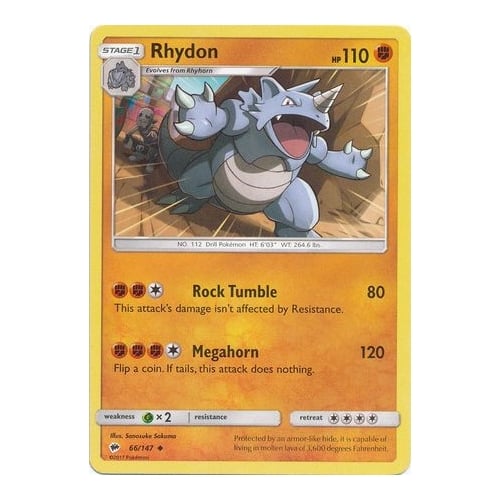 |
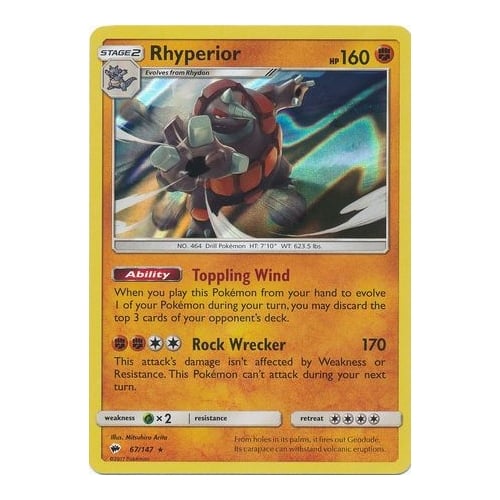 |
|---|
1× Rhyperior – Fighting (Rare)
3× Rhydon – Fighting (Uncommon)
3× Rhyhorn – Fighting (Common)
The Rhyhorn family is always going to be rock (heh) solid in any fighting deck. But these ones aren’t completely without caveats, as powerful as they may seem in terms of HP and sheer attack numbers. Rhyhorn is a pretty solid basic Pokémon — Lunge Out (C/C — 20) isn’t anything to write home about, but as usual Horn Drill (F/F/C — 60) is pretty great for a first form Pokémon.
Chances are you won’t get that far, though, as with 3 Rhydon in the deck you’ll be aiming to evolve. Rock Tumble (F/F/C — 80) is the star of the show and pretty useful, as it’s pretty good damage with the sweetener of ignoring resistance. While Megahorn (F/F/F/C — 120) may look tantalising as the damage is extreme, it’s living on the knife’s edge as it may fail if you flip tails. The smart move is to ignore this one, even though you may be tempted to dish out a solid 120 in some circumstances. But it could be your undoing.
Rhyperior is where it’s at, though there’s only 1 in the deck so drawing it may be a bit of a problem. Toppling Wind, its Ability, discards 3 cards from your opponent’s deck. While it’s nice to inconvenience your opponent this way, it’s not exactly a trump card ability. Rock Wrecker (F/F/C/C — 170) is where it gets divisive, but I’d argue this card isn’t as good as it seems because of it. 170 damage is insane, but it leaves Rhyperior unable to attack next turn.
Step up, maths-heads, what does that average out at? 85 damage per turn, a mere 5 more than Rhydon can dish out with its most basic move (and that ignores damage). During this time Rhyperior is easy prey for a prepared opponent to wreck damage, and even 160 HP isn’t much help in that kind of situation. The only true way to make best use of Rhyperior is being well prepared to forcefully negate the lack of attacking — either with an escape rope or similar card to pull him out of the action, or pay the toll of those valuable 4 energy cards to retreat him for a sort of “coup de grace” ending to a long game.
1× Lucario – Fighting (Rare)
2× Riolu – Fighting (Common)
Um, Rhyperior can move over for sure. Lucario should be a stronger element in this deck, no question. Stance is an immense Ability — though it means you’ll want to avoid evolving Riolu until you’re ready to have Lucario out. Submarine Blow (F/F/F — 120) hits pretty hard, and used in conjunction with Stance can dish out an unfettered 240 damage before any response can be met, meaning a surprise Lucario can take out just about any opposition, and then keep on handing out the pain.
Riolu’s Punch (F — 10) and Low Kick (F/F — 30) are also decent and respectable moves for a basic Pokémon. An ideal starter, and a very solid Pokémon family to focus your efforts on. The only real downside is it’d be better to have more representation of this gem in the deck build.
2× Solrock – Fighting (Uncommon)
Fairly unassuming, but you’ll be thankful of Double Draw (C) when you’re stalling in a card drought. With only 70HP Solrock will only be able to stand for a turn or two later on, but you might be able to make it work more earlier. Solar Heat (F — 20+) can do a pretty decent 40 if there’s a Stadium in play, but more often than not Solrock’s primary use is for the draw.
1× Sawk – Fighting (Common)
This one is just a bit weird, and I’m not sure I like it. While decent enough on its own, it just doesn’t really go anywhere. You can’t rely on Sawk to see you through, though it can be a good starting choice. Quick Guard (F) prevents damage done to Sawk next turn, but only on basic Pokémon, and you can’y use it next time. Brick Break (F/C — 40) is actually really solid — strong damage, and isn’t affected by resistance or other effects. Still, it can’t grow into much. It’s pretty limited in on being truly useful pretty early on in a match, or as a sacrificial, stalling stepping stone.
2× Meowstic – Psychic (Rare)
3× Espurr – Psychic (Common)
The only Psychic Pokémon family in this deck, and it surprisingly only needs 1 Psychic energy ever. Espurr is almost useless, as its only move is Perplexing Eyes (C), which changes the opponent’s weakness to Psychic until the end of the next turn. The only use in this deck is basically double Meowstic’s damage output the next turn if you evolve it, but it does cost you a turn, and isn’t really something you’ll be making use of.
Meowstic on the other hand can be a bit of a demon. If you don’t have many cards in your hand, Allure (P) will soak them right up 3 at a time, which feeds into Hand Kinesis (C/C — 10x) which does 10 damage for each card in your hand. If you’ve already got a bursting hand when you bring Meowstic out, you’re set to really lay out the pain. It seems innocuous at a glance, but Meowstic has the capability to lay out some untold damage if you use it right.
1× Bouffalant – Colorless (Uncommon)
We already discussed Bouffalant in the Luminous Frost section, so no photo for you. It serves much the same function here, though somehow feels a little bit less necessary. Bouffalant is a fairly chunky sort of card, so it feels like it pales next to some of the heavy hitters that Rock Steady are packed with. It’s sort of right at home, but that makes it feel a little bit less special here.
1× Acerola (Uncommon)
Acerola can actually be a bit of a life saver. This essentially lets you “reneg” a Pokémon on its last legs, effectively healing it. The amazing thing is getting every card attached back too. Nothing wasted except the turns spent attaching energy, but it’s well worth it.
1× Brooklet Hill (Uncommon)
Obviously this card is immediately not that great when faced off against Luminous Frost, as you’d both be able to make use of its ability. While it’s useful to be able to grab any basic Pokémon you want, you ideally shouldn’t have to at the cost of allowing your opponent to do the same. With two Nest Balls in the mix, as well as some good drawing ability from Solrock and Meowstic, it just doesn’t really seem necessary in this deck.
1× Energy Retrieval (Uncommon)
1× Escape Rope (Uncommon)
3× Hau (Uncommon)
2× Nest Ball (Uncommon)
1× Potion (Uncommon)
2× Professor Kakui (Uncommon)
1× Rescue Stretcher (Uncommon)
2× Timer Ball (Uncommon)
1× Wishful Baton (Uncommon)
6× Psychic Energy
14× Fighting Energy
Discussed in the deck general comments!
Closing Thoughts, and General Burning Shadows First Impressions
Obviously, as these theme decks include exclusive cards (well, shiny versions at least), true enthusiasts are going to want to pick these up no matter what. The exclusives themselves are pretty solid cards, but won’t be setting your decks alight. They are great to look at, though, and Rock Steady in particular will provide you a lovely Lucario and yes, Rhyperior if you must.
The biggest addition to the game with Sun & Moon are the Pokemon GX cards, which don’t make an appearance in either deck. Sure, these would be quite powerful to just give away, and they’re all rare pulls (though some older expansions have some GX cards in collector boxes). Newcomers will likely feel a bit sad that they can’t pop out that chunky GX counter to use in the matches.
It’s quite nice that both of these decks are pretty evenly matched, and don’t have any particular weaknesses against one another. That makes them pretty fun to play matches between the two, and allows you to focus on your own strategies rather than playing damage control to bad situations stacked against you. They do fall-back on some of the same cards between them, with near identical trainer lists, including the odd couple we’d happily ditch right away — Luminous Frost’s Big Malasada for instance (heals 20 damage and a special condition), is dead weight.
Despite having some Haus (draw 3 cards) and Professor Kakui (draw 2 cards, your attack does +20 damage), it was hard to deal with energy drought when it hit sometimes. Rock Steady has some Pokémon that can stall for draws (Solrock and Meowstic), but it’s not ideal.
Big shout out to the Wishful Baton, though, a new PokéTool included in both decks. When the Pokémon its attached to its knocked out, you can move 3 basic energy from it to a benched Pokémon. This can help bring your stronger Pokémon right into the fray even without an abundance of energy, and is especially helpful with some of Rock Steady’s high fighting energy costs, particularly with Rhyperior.
Overall Burning Shadows seems pretty solid so far, and it’s continuing to build on some of the unique flavours the Sun & Moon expansion has been delivering so far. Alolan forms were exciting in Sun & Moon, but gain whole new meaning in switching up what can be done in the Trading Card Game. As far as that’s concerned, Luminous Frost is the stronger deck for showcasing those unique forms, with Ninetails and Sandslash coming together like never before. But Rock Steady has some great cards too. Neither primary, featured ‘mons really jumped out at us.
No theme deck is going to be perfect, but these are both pretty good decks that provide ample room to get your hands dirty with, and the begin customising them with for your own playstyle and with some booster packs. If you can only get one, our money is on Luminous Frost for the novelty of the Alolan Forms, and because Rock Steady is a little bit too obsessed with the Rhyhorn group.



